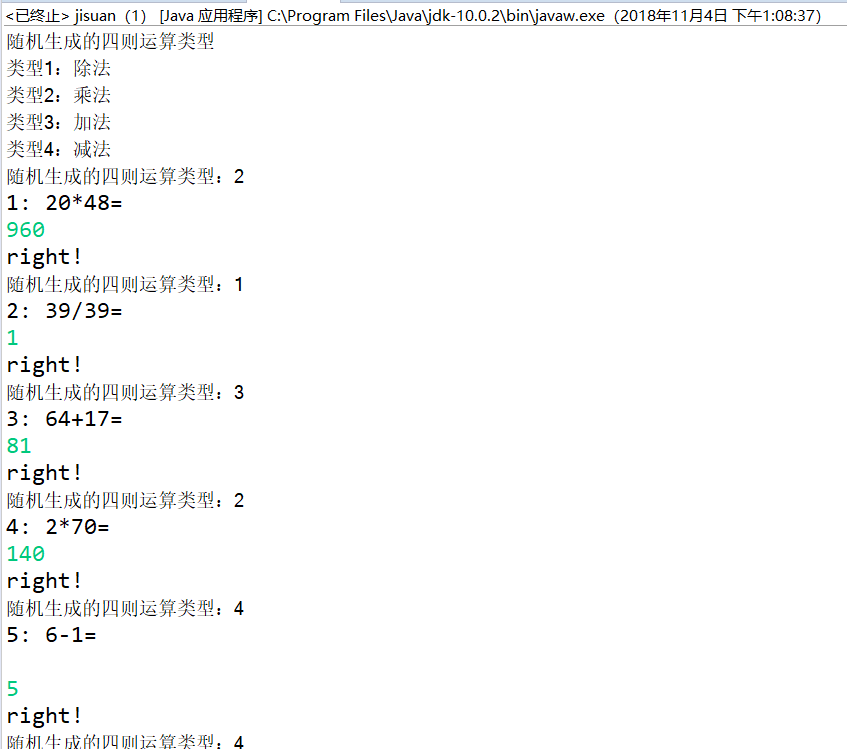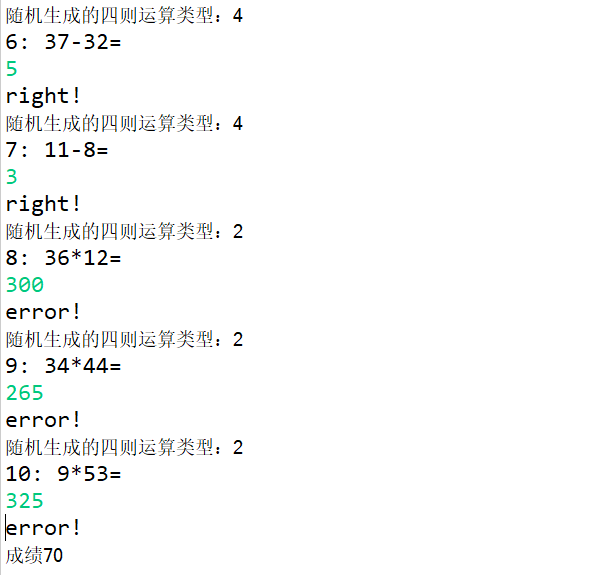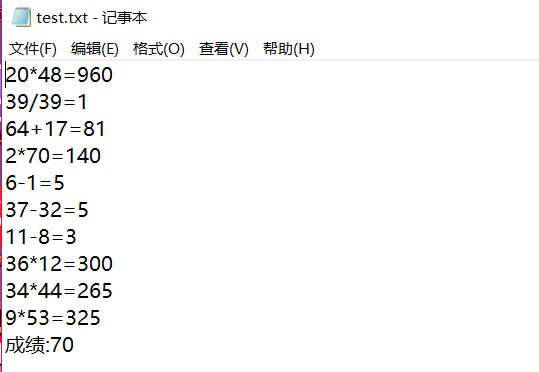201771010118 马昕璐《面向对象程序设计java》第十周学习总结
第一部分:理论知识学习部分
泛型:也称参数化类型(parameterized type)就是在定义类、接口和方法时,通过类型参数
指示将要处理的对象类型。
泛型程序设计(Generic programming):编写代码可以被很多不同类型的对象所重用。
一个泛型类(generic class)就是具有一个或多个类型变量的类,即创建用类型作为参数的类。如一个泛型类定义格式如下:
class Generics<K,V>
其中的K和V是类中的可变类型参数。
Pair类引入了一个类型变量T,用尖括号(<>)括起来,并放在类名的后面。
类定义中的类型变量用于指定方法的返回类型以及域、局部变量的类型
除了泛型类外,还可以只单独定义一个方法作为泛型方法,用于指定方法参数或者返回值为
泛型类型,留待方法调用时确定。
– 除了泛型类外,还可以只单独定义一个方法作为泛型方法,用于指定方法参数或者返回值为泛型类型,留待方法调用时确定。
第二部分:实验部分
1.实验名称:实验十 泛型程序设计技术
2.实验目的与要求
(1) 理解泛型概念;
(2) 掌握泛型类的定义与使用;
(3) 掌握泛型方法的声明与使用;
(4) 掌握泛型接口的定义与实现;
(5)了解泛型程序设计,理解其用途。
3.实验内容和步骤
实验1: 导入第8章示例程序,测试程序并进行代码注释。
测试程序1:
l 编辑、调试、运行教材311、312页 代码,结合程序运行结果理解程序;
l 在泛型类定义及使用代码处添加注释;
l 掌握泛型类的定义及使用。
package pair1;
/**
* @version 1.00 2004-05-10
* @author Cay Horstmann
*/
public class Pair<T> //Pair类引入一个变量
{
private T first;
private T second;
public Pair() { first = null; second = null; }
public Pair(T first, T second) { this.first = first; this.second = second; }
public T getFirst() { return first; }
public T getSecond() { return second; }
public void setFirst(T newValue) { first = newValue; }
public void setSecond(T newValue) { second = newValue; }
}
package pair1;
/**
* @version 1.01 2012-01-26
* @author Cay Horstmann
*/
public class PairTest1
{
public static void main(String[] args)
{
String[] words = { "Mary", "had", "a", "little", "lamb" };
Pair<String> mm = ArrayAlg.minmax(words);
System.out.println("min = " + mm.getFirst());
System.out.println("max = " + mm.getSecond());
}
}
class ArrayAlg
{
/**
* Gets the minimum and maximum of an array of strings.
* @param a an array of strings
* @return a pair with the min and max value, or null if a is null or empty
*/
public static Pair<String> minmax(String[] a)//返回值为实例化的类对象
{
if (a == null || a.length == 0) return null;//条件判断语句
String min = a[0];
String max = a[0];
for (int i = 1; i < a.length; i++)
{
if (min.compareTo(a[i]) > 0) min = a[i];
if (max.compareTo(a[i]) < 0) max = a[i];
}
return new Pair<>(min, max);
}
}
运行结果如下:

测试程序2:
l 编辑、调试运行教材315页 PairTest2,结合程序运行结果理解程序;
l 在泛型程序设计代码处添加相关注释;
l 掌握泛型方法、泛型变量限定的定义及用途。
package pair2;
/**
* @version 1.00 2004-05-10
* @author Cay Horstmann
*/
public class Pair<T> //定义Pair类,引入一个类型变量T
{
private T first;
private T second;
public Pair() { first = null; second = null; }
public Pair(T first, T second) { this.first = first; this.second = second; }
public T getFirst() { return first; }
public T getSecond() { return second; }
public void setFirst(T newValue) { first = newValue; }
public void setSecond(T newValue) { second = newValue; }
}
package pair2;
import java.time.*;
/**
* @version 1.02 2015-06-21
* @author Cay Horstmann
*/
public class PairTest2//定义公共类
{
public static void main(String[] args)
{
LocalDate[] birthdays =
{
LocalDate.of(1906, 12, 9), // G. Hopper
LocalDate.of(1815, 12, 10), // A. Lovelace
LocalDate.of(1903, 12, 3), // J. von Neumann
LocalDate.of(1910, 6, 22), // K. Zuse
};
Pair<LocalDate> mm = ArrayAlg.minmax(birthdays);//通过类名调用minmax方法
System.out.println("min = " + mm.getFirst());
System.out.println("max = " + mm.getSecond());
}
}
class ArrayAlg
{
/**
Gets the minimum and maximum of an array of objects of type T.
@param a an array of objects of type T
@return a pair with the min and max value, or null if a is
null or empty
*/
public static <T extends Comparable> Pair<T> minmax(T[] a) //加了上界约束的泛型方法
{
if (a == null || a.length == 0) return null;
T min = a[0];
T max = a[0];
for (int i = 1; i < a.length; i++)
{
if (min.compareTo(a[i]) > 0) min = a[i];
if (max.compareTo(a[i]) < 0) max = a[i];
}
return new Pair<>(min, max);
}
}
运行结果如下:

测试程序3:
l 用调试运行教材335页 PairTest3,结合程序运行结果理解程序;
l 了解通配符类型的定义及用途。
package pair3;
import java.time.*;
public class Employee//定义一个公共类
{
private String name;
private double salary;
private LocalDate hireDay;
public Employee(String name, double salary, int year, int month, int day)
{
this.name = name;
this.salary = salary;
hireDay = LocalDate.of(year, month, day);
}
public String getName()
{
return name;
}
public double getSalary()
{
return salary;
}
public LocalDate getHireDay()
{
return hireDay;
}
public void raiseSalary(double byPercent)
{
double raise = salary * byPercent / 100;
salary += raise;
}
}
package pair3;
public class Manager extends Employee
{
private double bonus;
/**
@param name the employee's name
@param salary the salary
@param year the hire year
@param month the hire month
@param day the hire day
*/
public Manager(String name, double salary, int year, int month, int day)
{
super(name, salary, year, month, day);
bonus = 0;
}
public double getSalary()
{
double baseSalary = super.getSalary();
return baseSalary + bonus;
}
public void setBonus(double b)
{
bonus = b;
}
public double getBonus()
{
return bonus;
}
}
package pair3;
/**
* @version 1.00 2004-05-10
* @author Cay Horstmann
*/
public class Pair<T> //定义公共类,Pair类引入一个类型变量T,用于指定方法的返回类型以及域、局部变量的类型
{
private T first;
private T second;
public Pair() { first = null; second = null; }
public Pair(T first, T second) { this.first = first; this.second = second; }
public T getFirst() { return first; }
public T getSecond() { return second; }
public void setFirst(T newValue) { first = newValue; }
public void setSecond(T newValue) { second = newValue; }
}
package pair3;
/**
* @version 1.01 2012-01-26
* @author Cay Horstmann
*/
public class PairTest3
{
public static void main(String[] args)
{
Manager ceo = new Manager("Gus Greedy", 800000, 2003, 12, 15);
Manager cfo = new Manager("Sid Sneaky", 600000, 2003, 12, 15);
Pair<Manager> buddies = new Pair<>(ceo, cfo);
printBuddies(buddies);
ceo.setBonus(1000000);
cfo.setBonus(500000);
Manager[] managers = { ceo, cfo };
Pair<Employee> result = new Pair<>();
minmaxBonus(managers, result);
System.out.println("first: " + result.getFirst().getName()
+ ", second: " + result.getSecond().getName());
maxminBonus(managers, result);
System.out.println("first: " + result.getFirst().getName()
+ ", second: " + result.getSecond().getName());
}
public static void printBuddies(Pair<? extends Employee> p)//表示带有上界
{
Employee first = p.getFirst();
Employee second = p.getSecond();
System.out.println(first.getName() + " and " + second.getName() + " are buddies.");
}
public static void minmaxBonus(Manager[] a, Pair<? super Manager> result)//定义泛型变量的下界,通过使用super关键字可以固定泛型参数的类型为某种类型或者其超类
{
if (a.length == 0) return;
Manager min = a[0];
Manager max = a[0];
for (int i = 1; i < a.length; i++)
{
if (min.getBonus() > a[i].getBonus()) min = a[i];
if (max.getBonus() < a[i].getBonus()) max = a[i];
}
result.setFirst(min);
result.setSecond(max);
}
public static void maxminBonus(Manager[] a, Pair<? super Manager> result)//表示带有下界
{
minmaxBonus(a, result);
PairAlg.swapHelper(result); // OK--swapHelper captures wildcard type
}
// Can't write public static <T super manager> ...
}
class PairAlg
{
public static boolean hasNulls(Pair<?> p)//"?"----类型变量的通配符,表示任何类型
{
return p.getFirst() == null || p.getSecond() == null;
}
public static void swap(Pair<?> p) { swapHelper(p); }//无限定通配符,可以用任意Object对象调用原始的Pair类的setObject方法。
public static <T> void swapHelper(Pair<T> p)
{
T t = p.getFirst();
p.setFirst(p.getSecond());
p.setSecond(t);
}
}
运行结果如下:

实验2:编程练习:
编程练习1:实验九编程题总结
l 实验九编程练习1总结(从程序总体结构说明、模块说明,目前程序设计存在的困难与问题三个方面阐述)。
程序总体结构:Main类和Student类
模块说明:Main类包含文件读取、抓错处理、case语句(选择操作)以及具体操作内容
Student类包含更改器访问器
困难与问题:抓错语句不熟练
import java.io.File;
import java.io.BufferedReader;
import java.util.Scanner;
import java.util.ArrayList;
import java.util.Arrays;
import java.io.FileInputStream;
import java.io.FileNotFoundException;
import java.io.IOException;
import java.io.InputStreamReader;
import java.util.Collections;
public class Test {
private static ArrayList<Student> studentlist;
public static void main(String[] args) {
studentlist = new ArrayList<>();
Scanner scanner = new Scanner(System.in);
File file = new File("F:\\身份证号.txt");
try {
FileInputStream fis = new FileInputStream(file);
BufferedReader in = new BufferedReader(new InputStreamReader(fis));
String temp = null;
while ((temp = in.readLine()) != null) {
Scanner linescanner = new Scanner(temp);
linescanner.useDelimiter(" ");
String name = linescanner.next();
String number = linescanner.next();
String sex = linescanner.next();
String age = linescanner.next();
String province = linescanner.nextLine();
Student student = new Student();
student.setName(name);
student.setnumber(number);
student.setsex(sex);
int a = Integer.parseInt(age);
student.setage(a);
student.setprovince(province);
studentlist.add(student);
}
} catch (FileNotFoundException e) {
System.out.println("学生信息文件找不到");
e.printStackTrace();
//加入的捕获异常代码
} catch (IOException e) {
System.out.println("学生信息文件读取错误");
e.printStackTrace();
//加入的捕获异常代码
}
boolean isTrue = true;
while (isTrue) {
System.out.println("选择你的操作,输入正确格式的选项");
System.out.println("A.字典排序");
System.out.println("B.输出年龄最大和年龄最小的人");
System.out.println("C.寻找老乡");
System.out.println("D.寻找年龄相近的人");
System.out.println("F.退出");
String m = scanner.next();
switch (m) {
case "A":
Collections.sort(studentlist);
System.out.println(studentlist.toString());
break;
case "B":
int max = 0, min = 100;
int j, k1 = 0, k2 = 0;
for (int i = 1; i < studentlist.size(); i++) {
j = studentlist.get(i).getage();
if (j > max) {
max = j;
k1 = i;
}
if (j < min) {
min = j;
k2 = i;
}
}
System.out.println("年龄最大:" + studentlist.get(k1));
System.out.println("年龄最小:" + studentlist.get(k2));
break;
case "C":
System.out.println("老家?");
String find = scanner.next();
String place = find.substring(0, 3);
for (int i = 0; i < studentlist.size(); i++) {
if (studentlist.get(i).getprovince().substring(1, 4).equals(place))
System.out.println("老乡" + studentlist.get(i));
}
break;
case "D":
System.out.println("年龄:");
int yourage = scanner.nextInt();
int near = agenear(yourage);
int value = yourage - studentlist.get(near).getage();
System.out.println("" + studentlist.get(near));
break;
case "F":
isTrue = false;
System.out.println("退出程序!");
break;
default:
System.out.println("输入有误");
}
}
}
public static int agenear(int age) {
int j = 0, min = 53, value = 0, k = 0;
for (int i = 0; i < studentlist.size(); i++) {
value = studentlist.get(i).getage() - age;
if (value < 0)
value = -value;
if (value < min) {
min = value;
k = i;
}
}
return k;
}
}
public class Student implements Comparable<Student> {
private String name;
private String number ;
private String sex ;
private int age;
private String province;
public String getName() {
return name;
}
public void setName(String name) {
this.name = name;
}
public String getnumber() {
return number;
}
public void setnumber(String number) {
this.number = number;
}
public String getsex() {
return sex ;
}
public void setsex(String sex ) {
this.sex =sex ;
}
public int getage() {
return age;
}
public void setage(int age) {
// int a = Integer.parseInt(age);
this.age= age;
}
public String getprovince() {
return province;
}
public void setprovince(String province) {
this.province=province ;
}
public int compareTo(Student o) {
return this.name.compareTo(o.getName());
}
public String toString() {
return name+"\t"+sex+"\t"+age+"\t"+number+"\t"+province+"\n";
}
}
实验九编程练习2总结(从程序总体结构说明、模块说明,目前程序设计存在的困难与问题三个方面阐述)。
程序总体结构:jisuan类
模块说明:文件的写入,随机生成加减乘除四则运算,返回得分
问题与困难:除法的结果带小数时运算不准确;在txt文件中只能写入得分
import java.util.Scanner;
import java.util.Random;
import java.io.FileNotFoundException;
import java.io.PrintWriter;
public class jisuan {
public static void main(String[] args) {
Scanner in = new Scanner(System.in);
yunsuan counter = new yunsuan();
PrintWriter out = null;
try {
out = new PrintWriter("text.txt");
} catch (FileNotFoundException e) {
// TODO Auto-generated catch block
e.printStackTrace();
}
int sum = 0;
System.out.println("随机生成的四则运算类型");
System.out.println("类型1:除法");
System.out.println("类型2:乘法");
System.out.println("类型3:加法");
System.out.println("类型4:减法");
for (int i = 1; i <= 10; i++) {
int a = (int) Math.round(Math.random() * 100);
int b = (int) Math.round(Math.random() * 100);
int m;
Random rand = new Random();
m = (int) rand.nextInt(4) + 1;
System.out.println("随机生成的四则运算类型:"+m);
switch (m) {
case 1:
System.out.println(i + ": " + a + "/" + b + "=");
while (b == 0) {
b = (int) Math.round(Math.random() * 100);
}
double c0 = in.nextDouble();
out.println(a + "/" + b + "=" + c0);
if (c0 == counter.division(a, b)) {
sum += 10;
System.out.println("right!");
} else {
System.out.println("error!");
}
break;
case 2:
System.out.println(i + ": " + a + "*" + b + "=");
int c = in.nextInt();
out.println(a + "*" + b + "=" + c);
if (c == counter.multiplication(a, b)) {
sum += 10;
System.out.println("right!");
} else {
System.out.println("error!");
}
break;
case 3:
System.out.println(i + ": " + a + "+" + b + "=");
int c1 = in.nextInt();
out.println(a + "+" + b + "=" + c1);
if (c1 == counter.add(a, b)) {
sum += 10;
System.out.println("right!");
} else {
System.out.println("error!");
}
break;
case 4:
System.out.println(i + ": " + a + "-" + b + "=");
int c2 = in.nextInt();
out.println(a + "-" + b + "=" + c2);
if (c2 == counter.reduce(a, b)) {
sum += 10;
System.out.println("right!");
} else {
System.out.println("error!");
}
break;
}
}
System.out.println("成绩" + sum);
out.println("成绩:" + sum);
out.close();
}
}
public class yunsuan {
private int a;
private int b;
public int add(int a, int b) {
return a + b;
}
public int reduce(int a, int b) {
return a - b;
}
public int multiplication (int a,int b){
return a*b;
}
public int division(int a,int b){
if(b!=0)
return a/b;
else
return 0;}
}
编程练习2:采用泛型程序设计技术改进实验九编程练习2,使之可处理实数四则运算,其他要求不变。
import java.io.PrintWriter;
import java.util.Random;
import java.util.Scanner;import java.io.FileNotFoundException;
public class jisuan {
public static void main(String[] args) {
Scanner in = new Scanner(System.in);
yunsuan counter = new yunsuan();
PrintWriter out = null;
try {
out = new PrintWriter("test.txt");
} catch (FileNotFoundException e) {
System.out.println("文件夹输出失败");
e.printStackTrace();
}
int sum = 0;
System.out.println("随机生成的四则运算类型");
System.out.println("类型1:除法");
System.out.println("类型2:乘法");
System.out.println("类型3:加法");
System.out.println("类型4:减法");
for (int i = 1; i <= 10; i++) {
int a = (int) Math.round(Math.random() * 100);
int b = (int) Math.round(Math.random() * 100);
int m;
Random rand = new Random();
m = (int) rand.nextInt(4) + 1;
System.out.println("随机生成的四则运算类型:" + m);
switch (m) {
case 1:
a = b + (int) Math.round(Math.random() * 100);
while(b == 0){
b = (int) Math.round(Math.random() * 100);
}
while(a % b != 0){
a = (int) Math.round(Math.random() * 100);
}
//若生成的除法式子必须能整除,且满足分母为0的条件,则a一定要大于b,且a模b的结果要为0。
System.out.println(i + ": " + a + "/" + b + "=");
int c0 = in.nextInt();
out.println(a + "/" + b + "=" + c0);
if (c0 == counter.division(a, b)) {
sum += 10;
System.out.println("right!");
} else {
System.out.println("error!");
}
break;
case 2:
System.out.println(i + ": " + a + "*" + b + "=");
int c = in.nextInt();
out.println(a + "*" + b + "=" + c);
if (c == counter.multiplication(a, b)) {
sum += 10;
System.out.println("right!");
} else {
System.out.println("error!");
}
break;
case 3:
System.out.println(i + ": " + a + "+" + b + "=");
int c1 = in.nextInt();
out.println(a + "+" + b + "=" + c1);
if (c1 == counter.add(a, b)) {
sum += 10;
System.out.println("right!");
} else {
System.out.println("error!");
}
break;
case 4:
while (a < b) {
b = (int) Math.round(Math.random() * 100);
}
//因为不能产生运算结果为负数的减法式子,所以a一定要大于b。若a<b,则重新生成b。
System.out.println(i + ": " + a + "-" + b + "=");
int c2 = in.nextInt();
out.println(a + "-" + b + "=" + c2);
if (c2 == counter.reduce(a, b)) {
sum += 10;
System.out.println("right!");
} else {
System.out.println("error!");
}
break;
}
}
System.out.println("成绩" + sum);
out.println("成绩:" + sum);
out.close();
}
}
public class yunsuan {
private int a;
private int b;
public int add(int a,int b)
{
return a+b;
}
public int reduce(int a,int b)
{
return a-b;
}
public int multiplication(int a,int b)
{
return a*b;
}
public int division(int a,int b)
{
if(b!=0)
return a/b;
else
return 0;
}
}



实验总结:本周学习了有关泛型的知识,泛型接口的定义与实现,学会运用泛型技术设计程序,了解泛型程序设计,理解其用途。但本周所学知识中通配符的运用理解还有待加强。
201771010118 马昕璐《面向对象程序设计java》第十周学习总结的更多相关文章
- 201871010115——马北《面向对象程序设计JAVA》第二周学习总结
项目 内容 这个作业属于哪个课程 https://www.cnblogs.com/nwnu-daizh/ 这个作业的要求在哪里 https://www.cnblogs.com/nwnu-daizh/p ...
- 201771010134杨其菊《面向对象程序设计java》第九周学习总结
第九周学习总结 第一部分:理论知识 异常.断言和调试.日志 1.捕获 ...
- 201871010132-张潇潇《面向对象程序设计(java)》第一周学习总结
面向对象程序设计(Java) 博文正文开头 项目 内容 这个作业属于哪个课程 https://www.cnblogs.com/nwnu-daizh/ 这个作业的要求在哪里 https://www.cn ...
- 扎西平措 201571030332《面向对象程序设计 Java 》第一周学习总结
<面向对象程序设计(java)>第一周学习总结 正文开头: 项目 内容 这个作业属于哪个课程 https://www.cnblogs.com/nwnu-daizh/ 这个作业的要求在哪里 ...
- 杨其菊201771010134《面向对象程序设计Java》第二周学习总结
第三章 Java基本程序设计结构 第一部分:(理论知识部分) 本章主要学习:基本内容:数据类型:变量:运算符:类型转换,字符串,输入输出,控制流程,大数值以及数组. 1.基本概念: 1)标识符:由字母 ...
- 201871010124 王生涛《面向对象程序设计JAVA》第一周学习总结
项目 内容 这个作业属于哪个课程 https://www.cnblogs.com/nwnu-daizh/ 这个作业的要求在哪里 https://edu.cnblogs.com/campus/xbsf/ ...
- 201777010217-金云馨《面向对象程序设计(Java)》第二周学习总结
项目 内容 这个作业属于哪个课程 https://www.cnblogs.com/nwnu-daizh/ 这个作业的要求在哪里 https://www.cnblogs.com/nwnu-daizh/p ...
- 201871010132——张潇潇《面向对象程序设计JAVA》第二周学习总结
项目 内容 这个作业属于哪个课程 https://www.cnblogs.com/nwnu-daizh/ 这个作业的要求在哪里 https://www.cnblogs.com/nwnu-daizh/p ...
- 201771010123汪慧和《面向对象程序设计Java》第二周学习总结
一.理论知识部分 1.标识符由字母.下划线.美元符号和数字组成, 且第一个符号不能为数字.标识符可用作: 类名.变量名.方法名.数组名.文件名等.第二部分:理论知识学习部分 2.关键字就是Java语言 ...
- 20155303 2016-2017-2 《Java程序设计》第十周学习总结
20155303 2016-2017-2 <Java程序设计>第十周学习总结 目录 学习内容总结 网络编程 数据库 教材学习中的问题和解决过程 代码调试中的问题和解决过程 代码托管 上周考 ...
随机推荐
- 【项目】Selenium和pymongo复习
import pymongo client = pymongo.MongoClient(host='localhost',port=27017) db = client.test collection ...
- Maven将代码及依赖打成一个Jar包的方式
Maven可以使用mvn package指令对项目进行打包,如果使用java -jar xxx.jar执行运行jar文件,会出现"no main manifest attribute, in ...
- C# 高级编程03----细节内容
一.名称空间 1.C#使用Using关键字可以列出所需类的名称控件. 它和C/C++ 中的#include不一样.using语句并没有在这些文件之间建立物理连接 2.使用using给名称空间指定别名 ...
- xpath定位动态iframe
使用xpath定位 driver.switch_to.frame(driver.find_element_by_xpath("//iframe[starts-with(@id, 'x-URS ...
- 2-1、FileBeat入门
FileBeat入门 要开始使用Filebeat设置,请安装并配置相关产品: 用于存储和索引数据的Elasticsearch. 用户界面的Kibana. 用于解析和增强数据的Logstash(可选). ...
- bootstrap学习(二)页面
响应式图片: //当图片大的时候,逐渐缩小浏览器大小,图片会显示为自适应大小 ,img-responsive <div class="container"> <d ...
- macos 命令行安装 ipa
macos 命令行安装 ipa 苹果发神经后itunes已经无法在安装app了,如果有知道的兄弟可以告诉我啊 ideviceinstaller 使用这个开源项目可以在macos下安装app brew ...
- Promise 返回值
then 和 catch 中返回 promise,会在这个 promise resolve 或 reject 的时候,把 resolve 或 reject 的结果作为参数传给后面的 then 或 ca ...
- ASP.NET MVC 执行流程介绍
Routing 组件 Controller Controller中可用的ActionResult MVC-View(使用的抽象工厂模式的视图引擎) 视图模型
- python tensorflow model
step01_formula # -*- coding: utf-8 -*- """ 단순 선형회귀방정식 : x(1) -> y - y = a*X + b (a ...
